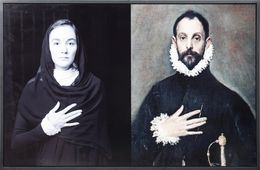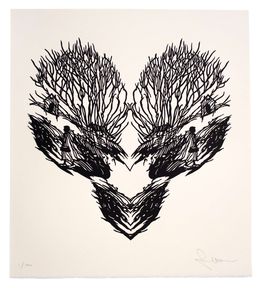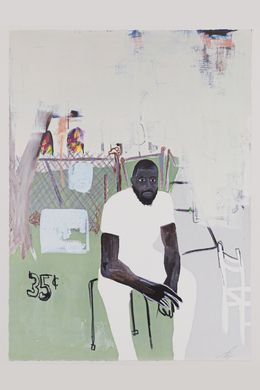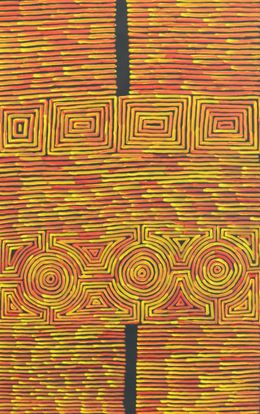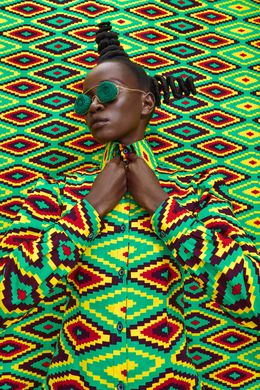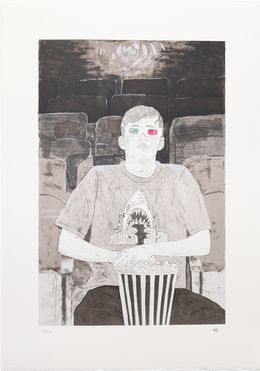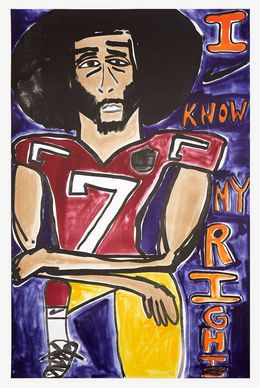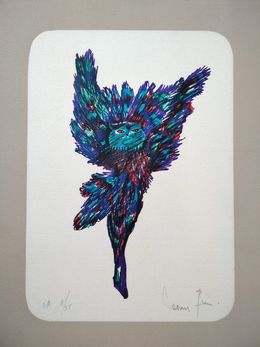
A Conversation with Robin Cembalest
The Evolution of Art and Media: a Conversation with Robin Cembalest

Robin at home with her bird plate collection and her mom's trompe-l'œil ceramic sculpture.
Robin Cembalest is a distinguished figure in the art world, known for her transformative work as both an art journalist and digital strategy consultant. With a career that spans from the editorial helm at ARTnews to her influential presence on Instagram, Robin has continuously adapted to the changing landscape of art and media. In this interview, she shares her journey, insights on the evolving art industry, and practical advice for artists looking to enhance their digital presence.
1. Hi Robin! Thank you for speaking with us today. Could you start by introducing yourself to our readers? How did your career as an art journalist begin?
Hi, I'm Robin Cembalest (she/her). In my business, Robin Cembalest Editorial Strategies, I teach art professionals how to craft a digital presence and how to write and speak about their work. I was an art journalist most of my career, but now I'm best known for my popular Instagram, @rcembalest, chronicling my travels in the New York art world and beyond.
My first job was at Artforum, epicenter of downtown cool and French theory in the '80s. I was the editorial assistant, doing fact-checking and photo research. Once, I had to call Andy Warhol at the Factory to ask if he peed on the Oxidation paintings. (He said yes.) I learned a lot at Artforum, including the fact that the theoretical and critical space the magazine inhabited was not for me. I wanted to be a news journalist. So I quit my job and moved to Madrid to become a foreign correspondent.
I didn't know anyone in Spain, or really anything about news writing, but eventually I found my way to the English-language part of EFE, the Spanish wire service. A kindly editor assigned me an obituary of Salvador Dalí, which took me the whole year I lived abroad. I worried that the nonagenarian artist would die before I finished, but Warhol died instead. Later, I published the Dalí obit in the Village Voice, where I started contributing regularly, along many other places.
In 1988 I became the news editor of ARTnews, the first of my two stints at the magazine. This is where I really learned journalism. As an editor, I worked on the magazine's award-winning investigative reporting on war loot and restitution. Meanwhile, as a reporter, I broke stories on my own, receiving prizes for my exposé on the Hispanic Society of America and producing major pieces on the culture wars, multiculturalism, the globalization of the Guggenheim, the Mapplethorpe obscenity trial, Native American art, ecological art, and many other topics.
2. Could you share some highlights from your time as the executive editor at ARTnews?
The time I was executive editor, 1998-2014, corresponded with so many transformations in the art and publishing industries. I greatly expanded the type of creative communities the magazine covered, around the world and in the U.S., diversifying the content and subject matter and introducing street art, graphic novels, and other forms of popular culture. I worked with writers including Carolina Miranda, Pamela Newkirk, Barbara Pollack, and so many more to highlight subjects and stories that hadn't been featured in mainstream art magazines. I trained and nurtured new generations of staff, many of them hired through the paid internship program I started and ran. I brought the interns everywhere, helping them build professional and cultural capital (and planting the seeds for my future in career development).
Another major achievement was bringing the 100-year-old magazine into the digital era. With the interns, I launched the online content section of the ARTnews website, wrote all of the initial content, and created the magazine's social media feeds.
3. What inspired you to transition from editorial work to consulting and coaching in social media and writing for art professionals?
Even as I was running the editorial department of ARTnews, I was experimenting on my own. I had two popular Tumblrs, a Wordpress blog, Snapchat, Vine, along with Twitter, Facebook, Instagram. So I saw the revolution in the way information was being disseminated and consumed over image-based social networks. When ARTnews was sold, in 2014, I decided to leave journalism and start a business training art professionals how to write and publish content for a mainstream audience across these digital channels. Since then I've worked with fairs, museums, nonprofits, galleries, professional organizations, and social justice organizations. With the rise of Zoom in the pandemic, I started teaching career development workshops online for residencies and schools nationwide. Now, I'm seeing a strong interest in professional training among schools as well as organizations offering continuing education. This year I joined the Career Development program at the Art Students League, and I just joined the faculty at the School of Visual Arts, where I'll be teaching professional development skills in the MFA Art Practice program.


Left: On assignment for Artforum at the Guggenheim Bilbao. / Right: Choosing portraits with artist Rashaad Newsome at the Ford Foundation Gallery. © Jane Kratochvil
4. What are some common challenges that artists and art organizations face when it comes to social media and content creation?
For many art professionals accustomed to writing academic texts, creating content for a wider audience can be a challenge. There's this pressure to lead with theory and meaning, the impulse to summon our distinctive industry artspeak to situate the work before you even say what it is. For organizations, it's all of the above, plus defining tasks and responsibilities–you need content management systems in place so your strategy doesn't walk out the door with every change in staff.
5. Can you share a success story where your strategies significantly improved an artist's or gallery's online presence?
One of my favorite projects was creating and implementing the social media strategy for the newly formed Ford Foundation Gallery. The themes of the shows were tied into the organization's larger mission of promoting social justice, using art to help change hearts, minds, policy. So the content had to convey that, while explaining and describing complex international artworks for a mainstream audience. I did the first year of content by myself, returning periodically to train and update staff.
6. What are your top three content tips for artists looking to enhance their digital presence?
Have that “elevator pitch"–a phrase or two that sums up who you are and what you do. Then, translate into the spoken word (elevator pitch), written word (statement) and mix of words and images (social media, website).
Highlight your tools, materials, process. Showing your studio as a place of transformation is the best advertisement for a studio visit.
Think about sharing, not selling. It's a long game in the art world, not a click-to-buy. Try not to get caught up in the stats–rather, think about the results you want off the app.


Left: Public speaking workshop at the International Studio and Curatorial Program. © Veronica Sanchez / Right: As an intern at the Metropolitan Museum of Art, Robin explains Morris Louis' “Alpha-Pi" to a tour group.
7. What emerging trends in digital media should artists and galleries be aware of?
Instagram remains the art industry's most dominant platform–if not by choice, then by necessity, until something else comes along. If, that is, you're not posting political content, photos that include women's nipples, or other content the platform routinely removes.
Of course you should be aware of Tik Tok, though that doesn't mean posting or even joining until you have a proper strategy, keeping in mind the platform's rocky legal status.
Finally, this is not an emerging trend, but I advise everyone to have a LinkedIn. It's a great way to be found.
8. Given the changing dynamics of the art market, what advice would you give to contemporary artists trying to navigate this landscape?
There are so many ways to define success and ways to get there. For some, success is defined by the market: selling a lot of paintings, having a solo gallery show. For very few, those things come right away. For most, it is essential to be creative about how you find and create opportunity: looking at open calls, artist registries, flat files, and so on, collaborating and organizing your own projects, and most of all building community. It's important to find your kindred spirits in our industry. You'll move around with them for decades.
9. How do you envision the future of communication and marketing within the art world?
With the decline in traditional media, it's harder to get traditional press coverage than ever. For individuals and businesses, digital content will become an even more urgent tool to bypass the remaining gatekeepers, connecting with audiences and influencers directly. Whatever the platform, the role of images and increasingly video will be center stage.
When I started my business a decade ago, the idea of a digital or social media department in an art gallery or a nonprofit was basically considered absurd. Now, we're seeing the rise of digital media departments in some of the larger museums that constitute a newly distinct editorial voice, demystifying what happens in the mothership while staging initiatives that increasingly involve the audience as creators and subjects. Although changing institutional DNA, collections, or even staff can take decades, museums' digital media departments can be nimble and nuanced, addressing issues like representation, heritage, identity. It's an evolving space where marketing, education, curatorial, and programming, among other departments, are collaborating in new ways.
10. What personal experiences or works of art have significantly influenced your approach to editorial strategy and consulting?
Right before I got to Artforum, I was an intern at the Metropolitan Museum of Art, in the education department. I gave tours of the modern and contemporary art section–a much less familiar topic to museumgoers back in the '80s. I remember taking groups through the Abstract Expressionist gallery, where earnest and curious visitors would ask, “Why is this here when my child could do that?" Or some version of that. What struck me was that the terms I knew from my art history studies about the dissolution of the picture plane wouldn't help me now. To most people, “formal" means the prom. So I had to develop a humanistic and accessible explanation that would make the “Why" Interesting from the audience's point of view. I followed that philosophy as a writer, editor, and now Instagrammer, and I share it with my students and clients.
Their favorite artworks
